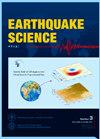使用ConvMixer网络预测峰值地面加速度
IF 4.1
4区 地球科学
Q3 Earth and Planetary Sciences
引用次数: 0
摘要
由峰值地加速度(PGA)确定的地震动水平可以用来分析某一地点的地震危险性,对抗震结构的建设至关重要。在地震发生后立即预测PGA可以使地震预警系统发出警告。在这项研究中,我们提出了一个深度学习模型,ConvMixer,以预测日本弱运动速度地震仪记录的PGA。我们使用5秒的三分量地震图,从地震前2秒到地震后3秒。我们的数据集包括2004年至2023年间K-NET、Kiki-NET和Hi-Net网络上10个地震台站记录的50,000多个单站波形。所提出的ConvMixer是一种基于patch的模型,它从输入的地震数据中提取全局特征,并通过结合深度卷积和点卷积来预测地震的PGA。当应用于测试集时,所提出的ConvMixer网络的平均绝对误差为2.143,优于基准深度学习模型。此外,所提出的ConvMixer能够根据p波到达时间后立即获得的1秒波形预测相应站点的PGA。本文章由计算机程序翻译,如有差异,请以英文原文为准。
Predicting peak ground acceleration using the ConvMixer network
The level of ground shaking, as determined by the peak ground acceleration (PGA), can be used to analyze seismic hazard at a certain location and is crucial for constructing earthquake-resistant structures. Predicting the PGA immediately after an earthquake occurs allows for the issuing of a warning by an earthquake early warning system. In this study, we propose a deep learning model, ConvMixer, to predict the PGA recorded by weak-motion velocity seismometers in Japan. We use 5-s three-component seismograms, from 2 s before until 3 s after the P-wave arrival time of the earthquake. Our dataset comprised more than 50,000 single-station waveforms recorded by 10 seismic stations in the K-NET, Kiki-NET, and Hi-Net networks between 2004 and 2023. The proposed ConvMixer is a patch-based model that extracts global features from input seismic data and predicts the PGA of an earthquake by combining depth and pointwise convolutions. The proposed ConvMixer network had a mean absolute error of 2.143 when applied to the test set and outperformed benchmark deep learning models. In addition, the proposed ConvMixer demonstrated the ability to predict the PGA at the corresponding station site based on 1-second waveforms obtained immediately after the arrival time of the P-wave.
求助全文
通过发布文献求助,成功后即可免费获取论文全文。
去求助
来源期刊

Earthquake Science
GEOCHEMISTRY & GEOPHYSICS-
CiteScore
1.10
自引率
8.30%
发文量
42
审稿时长
3 months
期刊介绍:
Earthquake Science (EQS) aims to publish high-quality, original, peer-reviewed articles on earthquake-related research subjects. It is an English international journal sponsored by the Seismological Society of China and the Institute of Geophysics, China Earthquake Administration.
The topics include, but not limited to, the following
● Seismic sources of all kinds.
● Earth structure at all scales.
● Seismotectonics.
● New methods and theoretical seismology.
● Strong ground motion.
● Seismic phenomena of all kinds.
● Seismic hazards, earthquake forecasting and prediction.
● Seismic instrumentation.
● Significant recent or past seismic events.
● Documentation of recent seismic events or important observations.
● Descriptions of field deployments, new methods, and available software tools.
The types of manuscripts include the following. There is no length requirement, except for the Short Notes.
【Articles】 Original contributions that have not been published elsewhere.
【Short Notes】 Short papers of recent events or topics that warrant rapid peer reviews and publications. Limited to 4 publication pages.
【Rapid Communications】 Significant contributions that warrant rapid peer reviews and publications.
【Review Articles】Review articles are by invitation only. Please contact the editorial office and editors for possible proposals.
【Toolboxes】 Descriptions of novel numerical methods and associated computer codes.
【Data Products】 Documentation of datasets of various kinds that are interested to the community and available for open access (field data, processed data, synthetic data, or models).
【Opinions】Views on important topics and future directions in earthquake science.
【Comments and Replies】Commentaries on a recently published EQS paper is welcome. The authors of the paper commented will be invited to reply. Both the Comment and the Reply are subject to peer review.
 求助内容:
求助内容: 应助结果提醒方式:
应助结果提醒方式:


